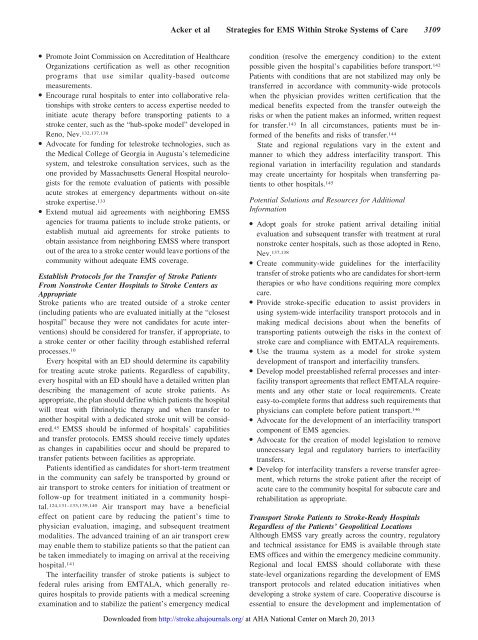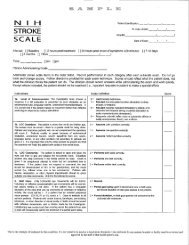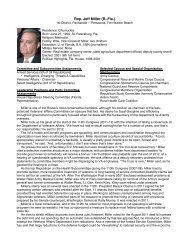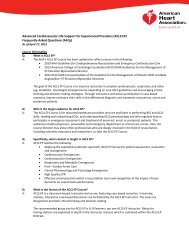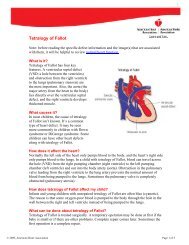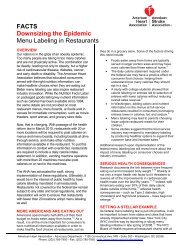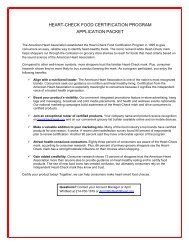2007 EMS Stroke Recommendations - American Heart Association
2007 EMS Stroke Recommendations - American Heart Association
2007 EMS Stroke Recommendations - American Heart Association
Create successful ePaper yourself
Turn your PDF publications into a flip-book with our unique Google optimized e-Paper software.
Acker et al Strategies for <strong>EMS</strong> Within <strong>Stroke</strong> Systems of Care 3109<br />
● Promote Joint Commission on Accreditation of Healthcare<br />
Organizations certification as well as other recognition<br />
programs that use similar quality-based outcome<br />
measurements.<br />
● Encourage rural hospitals to enter into collaborative relationships<br />
with stroke centers to access expertise needed to<br />
initiate acute therapy before transporting patients to a<br />
stroke center, such as the “hub-spoke model” developed in<br />
Reno, Nev. 132,137,138<br />
● Advocate for funding for telestroke technologies, such as<br />
the Medical College of Georgia in Augusta’s telemedicine<br />
system, and telestroke consultation services, such as the<br />
one provided by Massachusetts General Hospital neurologists<br />
for the remote evaluation of patients with possible<br />
acute strokes at emergency departments without on-site<br />
stroke expertise. 133<br />
● Extend mutual aid agreements with neighboring <strong>EMS</strong>S<br />
agencies for trauma patients to include stroke patients, or<br />
establish mutual aid agreements for stroke patients to<br />
obtain assistance from neighboring <strong>EMS</strong>S where transport<br />
out of the area to a stroke center would leave portions of the<br />
community without adequate <strong>EMS</strong> coverage.<br />
Establish Protocols for the Transfer of <strong>Stroke</strong> Patients<br />
From Nonstroke Center Hospitals to <strong>Stroke</strong> Centers as<br />
Appropriate<br />
<strong>Stroke</strong> patients who are treated outside of a stroke center<br />
(including patients who are evaluated initially at the “closest<br />
hospital” because they were not candidates for acute interventions)<br />
should be considered for transfer, if appropriate, to<br />
a stroke center or other facility through established referral<br />
processes. 10<br />
Every hospital with an ED should determine its capability<br />
for treating acute stroke patients. Regardless of capability,<br />
every hospital with an ED should have a detailed written plan<br />
describing the management of acute stroke patients. As<br />
appropriate, the plan should define which patients the hospital<br />
will treat with fibrinolytic therapy and when transfer to<br />
another hospital with a dedicated stroke unit will be considered.<br />
45 <strong>EMS</strong>S should be informed of hospitals’ capabilities<br />
and transfer protocols. <strong>EMS</strong>S should receive timely updates<br />
as changes in capabilities occur and should be prepared to<br />
transfer patients between facilities as appropriate.<br />
Patients identified as candidates for short-term treatment<br />
in the community can safely be transported by ground or<br />
air transport to stroke centers for initiation of treatment or<br />
follow-up for treatment initiated in a community hospital.<br />
124,131–133,139,140 Air transport may have a beneficial<br />
effect on patient care by reducing the patient’s time to<br />
physician evaluation, imaging, and subsequent treatment<br />
modalities. The advanced training of an air transport crew<br />
may enable them to stabilize patients so that the patient can<br />
be taken immediately to imaging on arrival at the receiving<br />
hospital. 141<br />
The interfacility transfer of stroke patients is subject to<br />
federal rules arising from EMTALA, which generally requires<br />
hospitals to provide patients with a medical screening<br />
examination and to stabilize the patient’s emergency medical<br />
condition (resolve the emergency condition) to the extent<br />
possible given the hospital’s capabilities before transport. 142<br />
Patients with conditions that are not stabilized may only be<br />
transferred in accordance with community-wide protocols<br />
when the physician provides written certification that the<br />
medical benefits expected from the transfer outweigh the<br />
risks or when the patient makes an informed, written request<br />
for transfer. 143 In all circumstances, patients must be informed<br />
of the benefits and risks of transfer. 144<br />
State and regional regulations vary in the extent and<br />
manner to which they address interfacility transport. This<br />
regional variation in interfacility regulation and standards<br />
may create uncertainty for hospitals when transferring patients<br />
to other hospitals. 145<br />
Potential Solutions and Resources for Additional<br />
Information<br />
● Adopt goals for stroke patient arrival detailing initial<br />
evaluation and subsequent transfer with treatment at rural<br />
nonstroke center hospitals, such as those adopted in Reno,<br />
Nev. 137,138<br />
● Create community-wide guidelines for the interfacility<br />
transfer of stroke patients who are candidates for short-term<br />
therapies or who have conditions requiring more complex<br />
care.<br />
● Provide stroke-specific education to assist providers in<br />
using system-wide interfacility transport protocols and in<br />
making medical decisions about when the benefits of<br />
transporting patients outweigh the risks in the context of<br />
stroke care and compliance with EMTALA requirements.<br />
● Use the trauma system as a model for stroke system<br />
development of transport and interfacility transfers.<br />
● Develop model preestablished referral processes and interfacility<br />
transport agreements that reflect EMTALA requirements<br />
and any other state or local requirements. Create<br />
easy-to-complete forms that address such requirements that<br />
physicians can complete before patient transport. 146<br />
● Advocate for the development of an interfacility transport<br />
component of <strong>EMS</strong> agencies.<br />
● Advocate for the creation of model legislation to remove<br />
unnecessary legal and regulatory barriers to interfacility<br />
transfers.<br />
● Develop for interfacility transfers a reverse transfer agreement,<br />
which returns the stroke patient after the receipt of<br />
acute care to the community hospital for subacute care and<br />
rehabilitation as appropriate.<br />
Transport <strong>Stroke</strong> Patients to <strong>Stroke</strong>-Ready Hospitals<br />
Regardless of the Patients’ Geopolitical Locations<br />
Although <strong>EMS</strong>S vary greatly across the country, regulatory<br />
and technical assistance for <strong>EMS</strong> is available through state<br />
<strong>EMS</strong> offices and within the emergency medicine community.<br />
Regional and local <strong>EMS</strong>S should collaborate with these<br />
state-level organizations regarding the development of <strong>EMS</strong><br />
transport protocols and related education initiatives when<br />
developing a stroke system of care. Cooperative discourse is<br />
essential to ensure the development and implementation of<br />
Downloaded from http://stroke.ahajournals.org/ at AHA National Center on March 20, 2013


